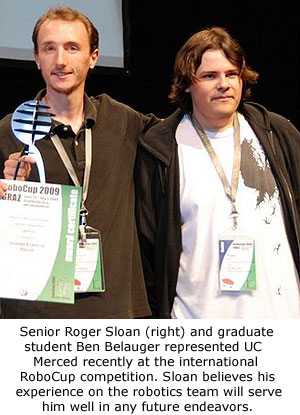

It may sound like just another contest, but for incoming seniors Derek Burch and Roger Sloan, the international
RoboCup competitionis so much more.
The duo, who helped UC Merced bring home the first-place trophy last week from the
RoboCup Rescue Simulationcompetition in Graz, Austria, have gotten real-world experience in
roboticsof which most undergraduates can only dream.
In the rescue simulation contest, UC Merced’s robotics team developed controls and coding to lead multiple robots on a search-and-rescue mission in a simulated urban disaster. The contest scenario involved a major earthquake in which robots go in before first responders to locate victims and determine structural stability.
The simulation scenario is a fitting one; research in robotics Urban Search and Rescue (USAR) became mainstream in the wake of the 1995 Kobe earthquake, which killed 5,500 and injured 26,000.
“The challenge in any search-and-rescue mission is that you want emergency personnel to rush in as soon as possible to help any survivors, but first responders also need to wait until an area is secure or else they risk injury or death along with those they are trying to help,” said
Professor Stefano Carpin, leader of UC Merced’s robotics team.
According to Carpin, in a mass-casualty disaster, it would be ideal for many robots to be deployed ahead of rescuers. However, in today’s market, that ideal is cost-prohibitive.
“Few research labs can afford 20 USAR robots,” he said. “Even a cutting-edge research facility like UC Merced only has two.”
Simulation contests such as RoboCup can explore the potential pros and pitfalls of using robots in rescue situations to work out any virtual kinks so that when they are practical to use, successful models are already in place.
“You use the same code to program simulated and real robots,” Carpin said. “Every year, the cost of creating robots decreases. This is a great way to test out what works and doesn’t work when using robots in rescue missions before buying 20 robots and putting them to the test during a real-life disaster.”
For Burch and Sloan, their place on the robotics team has been more than just an after-school project.
“We’ve definitely gotten practical experience,” Sloan said, adding that he and graduate student Ben Belauger, who controlled the robot during the simulation, worked 12 to 16 hours each day of the contest. “It was a collaborative environment that enabled me to practice what I’ve learned in the classroom.”
It’s also been a way to change the international face of robotics: The team’s winning code will be released to the public in hopes that others will use it and improve upon it.
“It’s not about winning the cup and keeping our knowledge a secret, it’s about solving the problem,” Carpin said. “The point is to spread around the best solution known so others can make it even better.”
Though that fact is part of what makes RoboCup so special, it can also be a little frightening for the winners.
”We had to work fast to get through the contest,” Burch said. “The code isn’t perfect, but it worked.”
For more information about robotics research at UC Merced, see
robotics.ucmerced.edu.






